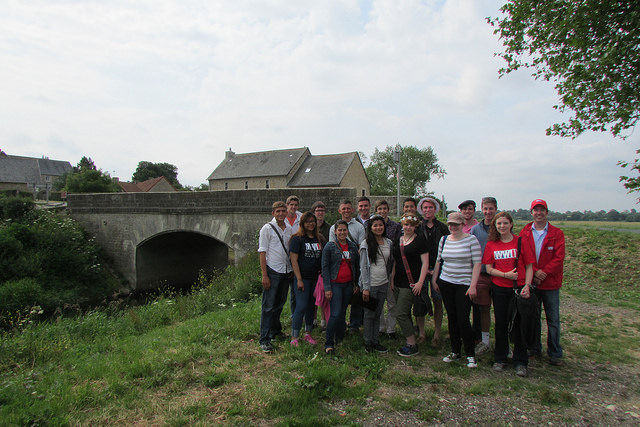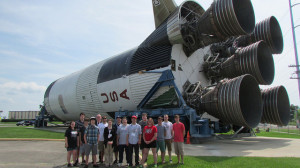Summer Leadership Students See the World as Their Classroom
For students attending The National WWII Museum’s Normandy Academy and Summer Residential Program, the “classroom” included Omaha Beach, Ste Mere Eglise, Jackson Barracks and the NASA Michoud Assembly Facility. Lessons in leadership and decision making ran throughout the programs, leaving a lasting impression on the students.
Normandy Academy

Normandy Academy students at La Fiere Bridge
The Normandy Academy began in New Orleans on June 21. Fifteen students from across the country arrived at the Museum after weeks of preparation by reading works from top WWII scholars and viewing oral histories from the Digital Collections of The National WWII Museum. At the Museum, the students examined all of factors facing General Dwight D. Eisenhower as he struggled with the decision to go on June 6, 1944. They also looked deeply into the issues surrounding the individual soldiers. Through a special tour, they were able to go inside a Sherman Tank and feel the cramped conditions firsthand. The most powerful Museum experience by far, was a conversation with Tom Blakey, a veteran of the 82nd Airborne Division who jumped into Normandy in the early morning hours on D-Day.
Once in France, the students set about their roles—debating strategic, moral and logistical decisions made in the Normandy campaign. The first stop was Pegasus Bridge where two students presented opposing views on whether several bridges could be effectively taken by paratroopers and held against German counterattacks until reinforcements arrived. After 20 minutes of presentation, the students concluded that it was the best course of action to take the bridges as the possibility of leaving infantry units stranded on the beaches could be disastrous.
Debates like this continued at each stop, including a superb debate over the merits of adding Utah Beach to the invasion plans. For adding the beach, the students argued that having infantry closer to the port of Cherbourg would speed the capture of a critical deep water port. Against the plans, students commented that the Germans would likely destroy the port before the Americans could capture it and that the distance between the two American landing beaches would be too great. Ultimately they decided the risks were worth it and that Utah should be added to the plans. While in France, students also took advantage of the many patisseries, cultural sites and a special light show on the Tree of Liberty near the Bayeux Cathedral.
Summer Residential Program

Summer Residential students with the First Stage Saturn V Moon Rocket at the NASA Michoud Assembly Facility
The Summer Residential Program examined critical leadership decisions that spanned the entire war. Students spent one week at the Museum with two special excursion days that expanded their understanding of leadership in WWII. Students began with an examination of the Arsenal of Democracy in the US Freedom Pavilion: The Boeing Center, followed by a discussion of how to best mobilize America’s workers and involve women in the war effort. After a closer examination of propaganda on the Home Front, the students debated how to handle John Abbot, a conscientious objector who refused any task that could aid the war effort in any way.
In the European Theater, students debated issues surrounding the invasion of Normandy, Operation Market Garden and Anzio. In the Pacific Theater, a discussion of whether General Jonathan Wainwright should surrender his forces on Corregidor showed how well versed in military protocol the students had become through their preparation and museum visits. An additional four stops were valuable to the experience. At the Chalmette Battlefield, the students saw and heard about British supply line issues in the Battle of New Orleans—an important detail that students kept in the back of their minds while discussing WWII battles. At Jackson Barracks, the headquarters of the Louisiana National Guard, students saw and heard how military tactics changed after WWII with new technology and strategy.
Two other stops would seem to have less to do with WWII but offered experiences that tied directly in to the program. A swamp tour near Pearl River allowed students to experience being on a flat-bottomed boat and see terrain that would prove unfamiliar to most Americans. A tour of the NASA Michoud Assembly Facility gave the students insight into large scale production processes of the kind that were taking place all across the United States to build war material for the military. After an exhilarating and informative week, the students ended with a quick tour of the French Quarter and a celebratory final dinner.
For more information on Summer Leadership opportunities for high school and college students, visit WWII Museum Tours or call 504-528-1944, ext. 257.
- Posted :
- Post Category :
- Tags :
- Follow responses to this entry through the RSS 2.0 feed. You can skip to the end and leave a response. Pinging is currently not allowed.




Leave a Reply